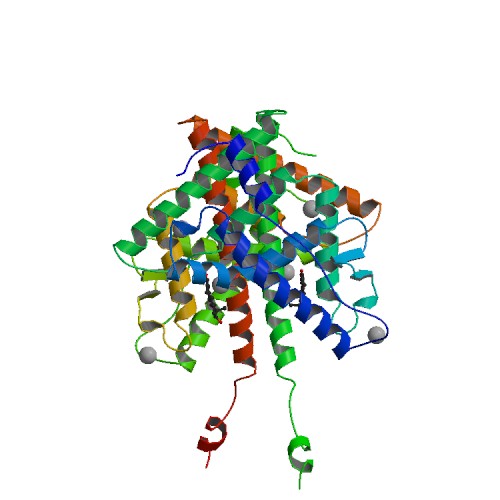Estrogen receptor alpha
Estrogen receptor alpha (ER-alpha), also known as NR3A1 (nuclear receptor subfamily 3, group A, member 1), is a nuclear receptor which is activated by the sex hormone estrogen. ER-alpha is encoded by the human gene ESR1 (EStrogen Receptor 1).[1]
The estrogen receptor (ESR) is a ligand-activated transcription factor composed of several domains important for hormone binding, DNA binding, and activation of transcription. Alternative splicing results in several ESR1 mRNA transcripts, which differ primarily in their 5-prime untranslated regions. The translated receptors show less variability.[supplied by OMIM][1]
References
Further reading
- McDonnell DP, Norris JD (2002). "Connections and regulation of the human estrogen receptor". Science. 296 (5573): 1642–4. doi:10.1126/science.1071884. PMID 12040178.
- Simoncini T, Fornari L, Mannella P; et al. (2003). "Novel non-transcriptional mechanisms for estrogen receptor signaling in the cardiovascular system. Interaction of estrogen receptor alpha with phosphatidylinositol 3-OH kinase". Steroids. 67 (12): 935–9. PMID 12398989.
- Lannigan DA (2003). "Estrogen receptor phosphorylation". Steroids. 68 (1): 1–9. PMID 12475718.
- Herrington DM (2003). "Role of estrogen receptor-alpha in pharmacogenetics of estrogen action". Curr. Opin. Lipidol. 14 (2): 145–50. doi:10.1097/01.mol.0000064045.68936.23. PMID 12642782.
- Tanaka Y, Sasaki M, Kaneuchi M; et al. (2004). "Estrogen receptor alpha polymorphisms and renal cell carcinoma--a possible risk". Mol. Cell. Endocrinol. 202 (1–2): 109–16. PMID 12770739.
- Ali S, Coombes RC (2004). "Estrogen receptor alpha in human breast cancer: occurrence and significance". Journal of mammary gland biology and neoplasia. 5 (3): 271–81. PMID 14973389.
- Olsson H (2004). "Estrogen receptor content in malignant breast tumors in men--a review". Journal of mammary gland biology and neoplasia. 5 (3): 283–7. PMID 14973390.
- Surmacz E, Bartucci M (2005). "Role of estrogen receptor alpha in modulating IGF-I receptor signaling and function in breast cancer". J. Exp. Clin. Cancer Res. 23 (3): 385–94. PMID 15595626.
- Evinger AJ, Levin ER (2005). "Requirements for estrogen receptor alpha membrane localization and function". Steroids. 70 (5–7): 361–3. doi:10.1016/j.steroids.2005.02.015. PMID 15862818.
- Wang CL, Tang XY, Chen WQ; et al. (2007). "Association of estrogen receptor alpha gene polymorphisms with bone mineral density in Chinese women: a meta-analysis". Osteoporosis international : a journal established as result of cooperation between the European Foundation for Osteoporosis and the National Osteoporosis Foundation of the USA. 18 (3): 295–305. doi:10.1007/s00198-006-0239-2. PMID 17089081.
- Keaveney M, Klug J, Gannon F (1992). "Sequence analysis of the 5' flanking region of the human estrogen receptor gene". DNA Seq. 2 (6): 347–58. PMID 1476547.
- Piva R, Gambari R, Zorzato F; et al. (1992). "Analysis of upstream sequences of the human estrogen receptor gene". Biochem. Biophys. Res. Commun. 183 (3): 996–1002. PMID 1567414.
- Reese JC, Katzenellenbogen BS (1992). "Characterization of a temperature-sensitive mutation in the hormone binding domain of the human estrogen receptor. Studies in cell extracts and intact cells and their implications for hormone-dependent transcriptional activation". J. Biol. Chem. 267 (14): 9868–73. PMID 1577818.
- Dotzlaw H, Alkhalaf M, Murphy LC (1992). "Characterization of estrogen receptor variant mRNAs from human breast cancers". Mol. Endocrinol. 6 (5): 773–85. PMID 1603086.
- Keaveney M, Klug J, Dawson MT; et al. (1991). "Evidence for a previously unidentified upstream exon in the human oestrogen receptor gene". J. Mol. Endocrinol. 6 (1): 111–5. PMID 2015052.
- Reese JC, Katzenellenbogen BS (1991). "Mutagenesis of cysteines in the hormone binding domain of the human estrogen receptor. Alterations in binding and transcriptional activation by covalently and reversibly attaching ligands". J. Biol. Chem. 266 (17): 10880–7. PMID 2040605.
- Schwabe JW, Neuhaus D, Rhodes D (1991). "Solution structure of the DNA-binding domain of the oestrogen receptor". Nature. 348 (6300): 458–61. doi:10.1038/348458a0. PMID 2247153.
- Tora L, Mullick A, Metzger D; et al. (1989). "The cloned human oestrogen receptor contains a mutation which alters its hormone binding properties". EMBO J. 8 (7): 1981–6. PMID 2792078.
- Ponglikitmongkol M, Green S, Chambon P (1989). "Genomic organization of the human oestrogen receptor gene". EMBO J. 7 (11): 3385–8. PMID 3145193.
- Greene GL, Gilna P, Waterfield M; et al. (1986). "Sequence and expression of human estrogen receptor complementary DNA". Science. 231 (4742): 1150–4. PMID 3753802.
This article incorporates text from the United States National Library of Medicine, which is in the public domain.
| This protein-related article is a stub. You can help Wikipedia by expanding it. |
